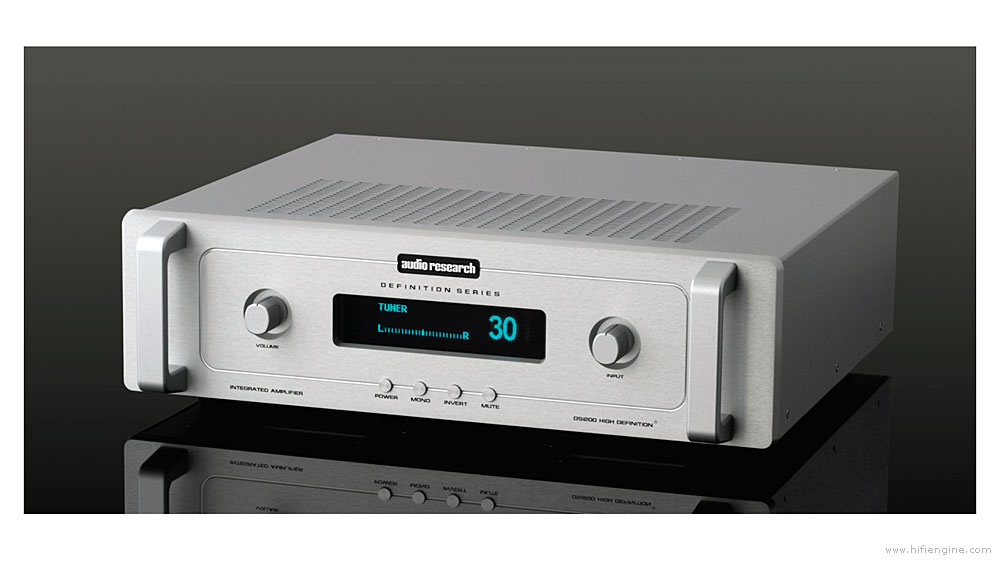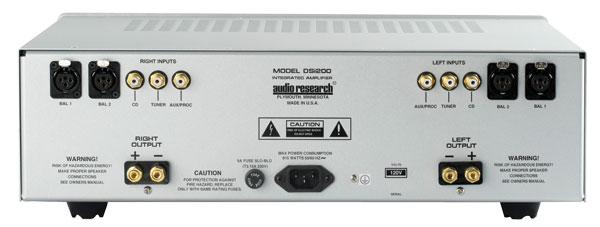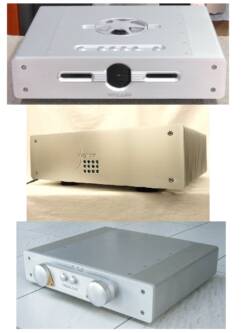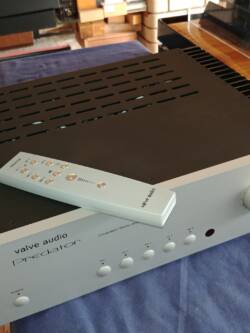Audio Research DSi200
Original price was: R95,000.00.R34,000.00Current price is: R34,000.00.
The DSi200 is our first product in the “Definition Series” showcasing a new technology that offers extremely high performance and value. Based on an advanced new design created entirely from the ground up by our engineering team, the DSi200 is built in-house by our own craftspeople.
The Definition Series of amplifiers represents an unusual type of “solid-state hybrid” design in which a massive, highly regulated, linear analog power supply is combined with a truly “green” discrete analog switching-MOSFET output stage for highly efficient power conversion and low power consumption. The analog power supply and all-discrete MOSFET output stage are pure Audio Research expressions and do not rely on prepackaged modules or other “OEM” solutions common to amplifiers from other manufacturers.

Many music lovers have not favored efficient switching amplifier designs because their sonics have been disappointing on an absolute basis. Class-D amplifiers could sound good but they did not possess the level of refinement found in the best discrete analog class-AB designs. The DSi200 is not a typical switching amplifier with a switching power supply, and it doesn’t sound like one – it will surprise you with its musical purity, low noise floor, uncanny resolution and startling dynamics.
The DSi200 delivers 200 WPC continuously into an 8-ohm load, 400+ WPC dynamically into 8 ohms, and 800+ dynamically into 4 ohms. In the real world, this allows the DSi200 to control large, power-hungry speakers with remarkable ease. All this is generated with almost no heat from a moderately sized enclosure – the DSi200 has earned an Energy Star rating.
The DSi200 is a fully balanced design offering two sets of balanced inputs and three sets of single-ended inputs. One set of single-ended inputs can be used as a normal line-level input or it can be converted into a home-theater passthrough. This is important because the preamplifier section of the DSi200 is passive, so its preamplifier and amplifier sections cannot be separated. The DSi200’s appearance is a modern evolutionary step for Audio Research that is both contemporary and familiar. The heavy front panel features Volume and Input selectors flanking a vacuum-flourescent display. The brightness of the display can be adjusted to one of six levels, plus off-nine small pixels remain lit as a discreet reminder that the unit is powered on.
Control functions under the display are actuated via four small, round aluminum buttons; functions include Power, Mono, Invert, and Mute. The supplied remote control accesses these functions, plus a Left-Right balance control, and Display Up and Display Down controls. Silver handles are standard, but the most striking visual update may be the silver chassis that matches the handles and knobs. The DSi200 is also available with a black front panel, handles and knobs, but the chassis and wraparound cover will only be available in silver.
Connect the DSi200 to any speaker you have on hand and prepare to be amazed by how fluently this amplifier conveys the music from a soundstage that is wide and deep. It is rare to hear this level of articulation and purity from a single component, but the DSi200 has them both. Resolution is exceptional, with a presentation wonderfully relaxed because of its lack of grain and the absence of electronic artifacts. Fed by a high quality source, the DSi200 will have you playing recording after recording, revealing a captivating new level of performance from your speakers. It will not matter if you have inefficient or low impedance speakers because they will be controlled effortlessly. If an amplifier anywhere near its price ever deserves the overused accolade of “breakthrough,” it should be the DSi200. Contact your authorized Audio Research dealer to hear the sound of the future, the DSi200.
Audio Research DSi200 Integrated Amplifier (TAS 204)

When it comes to tube electronics few high-end companies speak as authoritatively and have been as honored as the Audio Research Corporation. On a far more personal note is the memory of a system I regularly enjoyed thirty years ago at a friend’s home–an ARC SP3a preamp and D150 power amp driving Magneplanar Tympani 1Ds, which had speed and transparency on a scale that gives me goosebumps to this day. ARC’s solid-state line, on the other hand, while highly respected has not been recipient of the kind of reverence reserved for its tube offerings. However, ARC’s latest, the new DSi200 integrated amp, makes a stronger case than ever. It’s a solid-state design with a secret.
 From any point of view, the look of the DSi200 is pure Audio Research—from its classic squared line, to the heavy front panel and chunky grab handles. Large volume and input selectors flank a vacuum-fluorescent display whose brightness has six levels of adjustment. Beneath the display are four aluminum buttons for power on/off, mono/stereo, inverting phase, and muting output. These same functions, as well as a balance control and display adjustments, are also provided by a full-function remote control. The back panel sports three single-ended inputs and a pair of balanced inputs—their mirror-like, symmetrical layout exposing the dual-mono design of the amp’s circuit. The DSi200 is also available with a black front panel, handles, and knobs, but the chassis and wraparound cover are only be available in silver.
From any point of view, the look of the DSi200 is pure Audio Research—from its classic squared line, to the heavy front panel and chunky grab handles. Large volume and input selectors flank a vacuum-fluorescent display whose brightness has six levels of adjustment. Beneath the display are four aluminum buttons for power on/off, mono/stereo, inverting phase, and muting output. These same functions, as well as a balance control and display adjustments, are also provided by a full-function remote control. The back panel sports three single-ended inputs and a pair of balanced inputs—their mirror-like, symmetrical layout exposing the dual-mono design of the amp’s circuit. The DSi200 is also available with a black front panel, handles, and knobs, but the chassis and wraparound cover are only be available in silver.
The aforementioned secret is the DSi200’s solid-state-hybrid design. It combines a hefty regulated analog linear power supply with a discrete MOSFET-based high-speed switching output stage of ARC’s own invention. While this implementation is not unique, ARC points out that, unlike virtually all other switching amplifiers, the DSi200 does not rely on any OEM modules or pre-manufactured components. The resulting amplifier outputs 200Wpc continuous into 8 ohms (300W into 4 ohms) with very high efficiency energy conversion—over 90%. Typical of this class of amp, the DSi200 runs very cool and because it draws only a scintilla of power at idle it garnered an “Energy Star” rating
I had the DSi200 powered up for only a few minutes when it became plain how authoritatively it reproduced music, particularly the lower mids and bass. Its ease and realism with pitch and timbre in the “nether regions” were superb. However, my broader impression was that the upper mids and treble range seemed out of character for an Audio Research component—they were a bit congested and tightly wound, and not playing ball with the mids. Since ARC is straightforward in stating that a significant amount of break-in time is required before the DSi200 settles in, I realized I would be remiss in not taking this caveat seriously. Long story short: I left the amp powered up cycling through the blips, ticks, and bumps of an Isotek burn-in disc for about a week straight without doing any serious listening. And the envelope please…
The difference was actually quite astonishing. Like a singer clearing her throat, the voice of the amp seemed to drop into a deeper more grounded place as if finally breathing from its diaphragm. It shed its papery thinness and smoothed out, like someone evening the wrinkles from fine bed linen. Violin, cello, dreadnought acoustic guitar, and even mandolin began resonating more fully and deeply. The DSi200 does not communicate an overtly sweet character in the sense of a darkened ripened treble, but neither does any astringency sour the top octaves. When I listen to violinist Arturo Delmoni play the “Allemande” from the Bach Partita No. 2 [Water Lily], I hear a sound that is neither shaded or spot-lit—just a marvelous sense of movement and action beyond the confines of the instrument itself. In this instance, there’s the thicker sound and increased body of the instrument coming into focus as Delmoni leans on the bow, digging into the strings for more volume and color. The ARC also reveals the air and open space looming behind the player, adding to the acoustic backbone of the performance. It individuates images and timbres with ease while also reproducing the interplay of textures within the soaring wind section during the playful allegro molto of Copland’s Third Symphony [Reference Recordings]. The stabs of brass, bass drum, and cascades of tympani during “Fanfare for the Common Man” were nothing less than electric. The DSi200’s grip on low-frequency pitches and timbres is steadfast; electric bass, kick drums, low percussion never lag or blur. Bass response is not overpowering but fast on its feet, allowing an acoustic bass to exhibit both volume and pace, not an easy act to balance. When it comes to midbass oomph, the DSi200 just seems to pull reserves from a seemingly bottomless well and yet never seems short of control even while driving demanding loads like the Magico V2 or TAD CR-1 loudspeakers.
.jpg) This amp’s strongest suit is, far and away, imaging. Images are uncommonly specific and stable. The resolution of low-level inner voices and harmonies will keep you on the edge of your seat, as you uncover heretofore buried information. And it deftly negotiates complex orchestral passages—the second movement from Brahms’ Symphony No. 4 [DG/Esoteric], for example—drawing boundaries, defining groupings. And in spite of its excellence tracking the subtle cues and quirks of individual players, I never felt it deemphasized the totality of the performance.
This amp’s strongest suit is, far and away, imaging. Images are uncommonly specific and stable. The resolution of low-level inner voices and harmonies will keep you on the edge of your seat, as you uncover heretofore buried information. And it deftly negotiates complex orchestral passages—the second movement from Brahms’ Symphony No. 4 [DG/Esoteric], for example—drawing boundaries, defining groupings. And in spite of its excellence tracking the subtle cues and quirks of individual players, I never felt it deemphasized the totality of the performance.
Followers of ARC tube efforts will be wondering how the DSi200 measures up against its prized valve rigs. Certainly the extent to which you embrace the sonics of the ARC hybrid will depend on your expectations. Which is to say, if you were expecting the DSi to sound like an ARC 610T, or like tubes in general, you may be disappointed. In a way, its personality goes to the heart of the divide between tubes and other output devices. Its sonics do possess a glimmer of midrange warmth—of that there’s no doubt. But if you take, for example, a tube integrated amp like Tim de Paravacini’s estimable EAR 834, the EAR will charm you senseless with its warmer mids and liquid top end—and a soothing quality that solid-state still doesn’t quite capture. But then there’s the ARC’s tight-fisted grip in the bottom end. And the way it plays the inside game of audio with beautifully graduated microdynamics. It has an instantaneous reaction time—it jumps on dynamics. If it can’t quite impart the same level of air and sensuous intimacy as its own tube brethren, it has its own level of physicality and power that is equally compelling.
So if you’re willing to engage the DSi on its own terms, then you’ll realize it is its own unique animal. On a disc like Rosanne Cash’s Black Cadillac [Capitol], the transient speed of flat-picked acoustic guitars is so blazingly fast you can almost feel the sting of the pick radiating down your own wrist. Cash’s vocals are beautifully focused; electric bass is tuneful and precise. Speaking of which, the ARC communicates the surface reverberation of drums in such a way that constantly reminded me of the spring of a trampoline as I listened to Jennifer Warnes’ “Way Down Deep” on The Hunter [Private].
However its replication of soundstage depth is decidedly mid-pack. True, it does an excellent job delineating individual images and sections of instruments, but when it comes to deep soundstage space it reaches a threshold that in my room is about two-thirds of the way to the wall behind the speakers but generally no further. And in spite of its neutrality, I still find massed strings a bit lacking in buoyancy, as if the amp focuses more strongly on the transient entrance of a note, that note’s edge information, and a pinch less on its residual bloom and the duration of its decay.
Given the hybrid nature of the DSi200, I’ve reflected on our survey of Class D amplifiers published a few years ago (Issue 168). In that article the editorial staff, having listened to a cross-section of amplifiers, came to similar conclusions—that while the amps tended to have superior bass response, slam, and control, their top ends seemed less resolved and shaded, and dynamically a bit lifeless. Whether they were ready for “prime time” became a subject of some controversy—and amongst the staff, not too many hearts were set aflutter. The point here is that the DSi200 is at least a couple generations removed from that world and deserves to be assessed and ranked with the most competitive amplifiers in its segment, regardless of class.
The DSi200 sonically stands its ground with the cream-of-the-crop in high-power integrated amplifiers. And I’m talking about efforts from the likes of Pass Labs, Magnum Dynalab, Simaudio, and Plinius. ARC deserves to be commended for wading into the controversial waters that roil around Class D amplification—a potentially thankless course for a company so strongly associated with tubes. But inspiration and a lot of engineering elbow-grease have produced a terrific integrated amp, comfortable in virtually every sonic environment and priced aggressively. ARC’s new powerhouse is a cool surprise from the company known for turning up the heat.
Description
| Power output | 200 watts per channel into 8 ohms. 300 watts per channel into 4 ohms, both channels driven, 1% THD. |
|---|---|
| Power bandwidth | |
| Frequency response | (-3dB points at 1 W) 5Hz to 55 kHz. |
| Input sensitivity | 0.93V RMS for rated output. (32.7 dB Gain) single-ended or balanced. |
| Input impedance | 60K ohms single-ended, 120k ohms balanced differential. |
| Output taps | |
| Output regulation | 0.06dB 8 ohm load to open circuit |
| Overall negative feedback | |
| Damping factor | 167 |
| Distortion | |
| Slew rate | |
| Rise time | |
| Hum & noise | 800 microvolts RMS (94dB below rated output IHF A-weighted.) |
| Power supply energy storage | 160,000 uF total. |
| Power requirements | 100-125VAC 60Hz (200-250VAC 50 Hz) 445 watts at rated output (200WPC 8 ohms) 735 watts at 300WPC 4 ohms, 38 watts idle. Standby 1 watt. |
| Other | Maximum input: 20V RMS BALANCED, 10V RMS SE Output polarity: Non-inverting from single-ended inputs. Balanced pin 2+ (IEC-268). Inputs: (5): BAL 1, BAL 2, CD(SE), Tuner(SE), Aux(SE). Controls: Volume (104 steps), Select Input. Push Buttons: Power, BAL/SE, Mono, Mute. |
| Dimensions | 19″ (48 cm) W(standard rack panel) x 5.25″ (13.3 cm) H x 14.25″ (36.2 cm) D (front back panel). Optional handles extend 1.5″ (3.8 cm) forward of the 1/4″ thick front panel. Output connectors extend 0.9″ behind rear panel. |
| Weight | 37.2 lbs. (16.9 kg) Net; 43.3 lbs. (19.7 kg) Shipping. |










Reviews
There are no reviews yet.